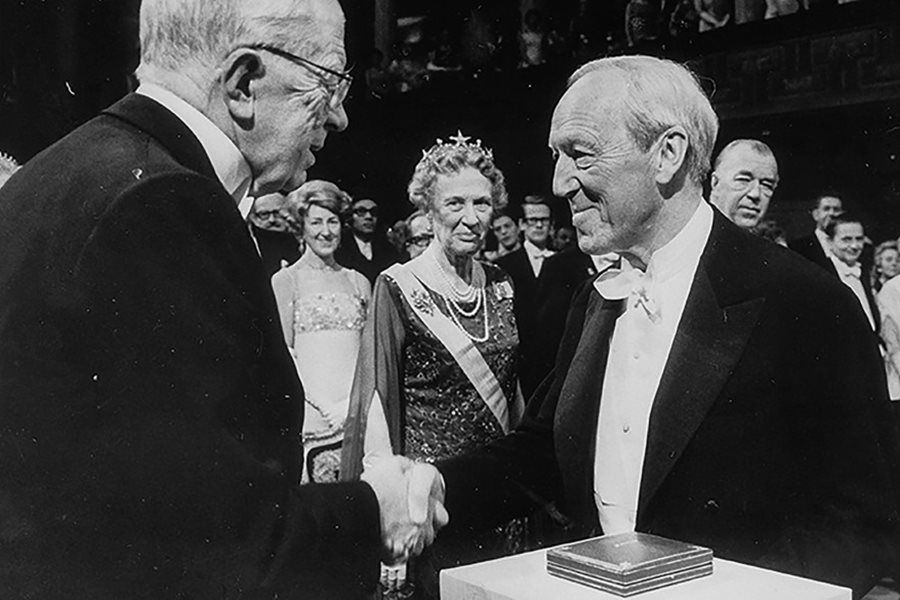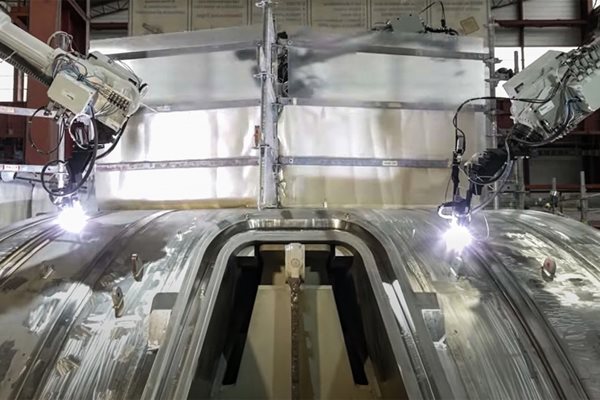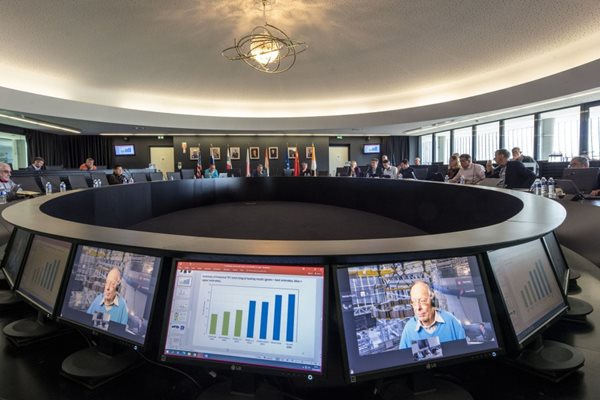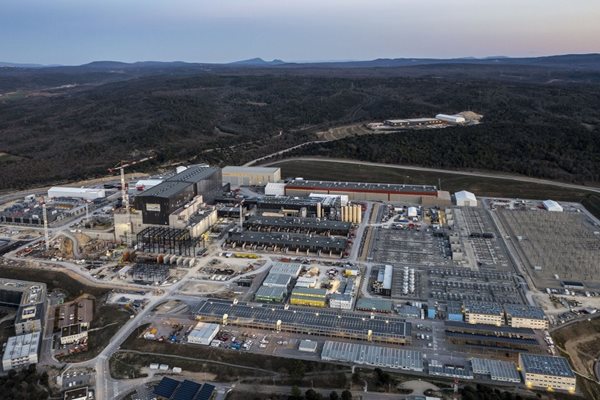
you're currently reading the news digest published from 11 Apr 2023 to 17 Apr 2023
featured4
press17
featured
Fusion world | Who was Hannes Alfvén?
If you are a plasma physicist, you certainly know all about Hannes Alfvén (äl′vān / pronounced AL-vee-en) already—but what about the rest of us? And why does his name keep cropping up in association with ITER? In 1970, Hannes Alfvén became the first—and to date only—plasma physicist to win the Nobel Prize. He had an extraordinary career, extending well beyond his eightieth birthday, and published over 300 papers and a dozen books.¹ Alfvén played a central role in the development of plasma physics and charged particle beams, and areas of technology benefitting from his contributions include controlled thermonuclear fusion, particle accelerators, hypersonic flight and rocket propulsion. He earned 15 major awards, and was one of only a handful of scientists who was a foreign member of both the United States and Soviet Academies of Sciences. He was also an accomplished linguist, speaking Swedish, English, German, French and Russian—as well as some Spanish and Chinese. Alfvén is known for Alfvén Waves, the Alfvén Speed, the Alfvén—Klein model, and Alfven's theorem—and asteroid 1778 Alfvén is named after him. As if that's not enough, there's also the Hannes Alfvén Prize, awarded annually by the European Physical Society (EPS) for 'outstanding contributions in plasma physics' and a Hannes Alfvén Medal, awarded for 'outstanding scientific contributions towards the understanding of plasma processes in the solar system.' Hannes Olof Gösta Alfvén was born in Sweden in 1908. His parents were both practicing physicians—and his mother was one of the first female doctors to qualify in Sweden. As a schoolboy, he was fascinated by Camille Flammarion's book on astronomy, Astronomie Populaire, and he and his friends formed an amateur radio club, building receivers. He later attributed some of his future success to applying an electromagnetic point of view to astrophysical problems. After studying at Uppsala University from 1926, Alfvén was awarded his PhD in 1934, with his doctoral thesis entitled Investigations of High-frequency Electromagnetic Waves. In September 1934, he was shown around the Radium Institute by Irène and Frédéric Joliot-Curie, who were to jointly win the Nobel Prize the following year for discovering that radioactive atoms could be created artificially. He then went on to spend six months in Cambridge, working with Ernest Rutherford (who had himself won the Nobel Prize in 1908), at the famous Cavendish Laboratory, before returning to Sweden. Alfvén taught physics in Uppsala and Stockholm and was awarded a full professorship at the Royal Institute of Technology in Stockholm in 1940, at the age of just 32. Alfvén waves and magnetohydrodynamics Just two years later, in 1942, in a letter to Nature, Alfvén made the case for the mutual interaction between electromagnetic fields and fluid motion, and the waves that resulted, in a simple and clear mathematical form. Essentially, he was predicting that magnetic field lines in a plasma, like guitar strings, could transmit a wave. At the time, the idea was ridiculed, but he was subsequently proved right, and the waves became known as Alfvén waves. Here on planet Earth, they can act as major particle accelerators. The letter to Nature resulted in the opening up of a whole new field of physics—that of magnetohydrodynamics (MHD). At the time, there were no known applications, as plasmas only occur naturally very rarely on Earth—essentially only in the aurorae and lightning. By the 1950s, however, technology advances meant that it was possible to generate high-temperature plasmas in the laboratory, and for these, an understanding of MHD was essential. MHD—even by the standards of higher physics—is famously and fiendishly complicated, combining the challenges of hydrodynamics and electromagnetism. Patrick Blackett—who worked with Ernest Rutherford for a decade, and who himself won the Nobel prize in 1948—is said to have told his students: 'Electromagnetism is difficult, hydrodynamics is very difficult, but magnetohydrodynamics is damned difficult.' In 1955, Alfvén went to the Kurchatov institute in Moscow to meet Lev Andreyevich Artsimovich and his researchers. Artsimovich had become the head of the former Soviet Union's fusion power program in 1951, and is widely credited as being the father of the tokamak, at the time a brand-new concept for a nuclear fusion reactor. (Artsimovich was once asked how long it would be before the first thermonuclear reactor would start to work. 'When mankind needs it,' he responded. 'Maybe a short time before that.') Three years later, in 1958, when a great deal of nuclear fusion research became declassified, Alfvén gave a keynote speech in Geneva at the Second United Nations International Conference on the Peaceful Uses of Atomic Energy—better known as 'Atoms for Peace'. Alfvén spoke on MHD and its application to thermonuclear problems, proposing that high temperature plasma be injected into a magnetic field, where it would be trapped—as is the case with auroral plasmas in the earth's magnetic field. Doesn't all that sound a lot like what ITER is aiming to do? In 1970, Alfvén was awarded the Nobel Prize for Physics for his work on MHD, and gave his Nobel Lecture on "'Plasma physics, space research and the origin of the solar system."² As a committed humanist, Alfvén was deeply concerned about the environment and population growth, and grew to oppose conventional nuclear power, becoming increasingly doubtful about the long-term safety of high-level radioactive waste. He died at the age of 86 in 1995—but his influence lives on, everywhere. And perhaps nowhere more so than at ITER, as scientists work to create, manage and harness magnetically confined very-hot plasma to deliver the dream of controlled thermonuclear fusion. ¹ See a detailed biography from The Royal Society here. ² Read the full text of his Nobel Lecture here.
Vacuum vessel welding | Robots at work
Contained in every double-walled sector of the ITER vacuum vessel are approximately 1.5 kilometres of welds. The Spanish firm Equipos Nucleares SA (ENSA)—sub-contractor to Europe's vacuum vessel consortium AMW—is using robots for part of the task, finding that they offer substantial timesavings and result in fewer distortions. The European Domestic Agency Fusion for Energy (F4E) has entrusted the AMW consortium (Ansaldo Nucleare, Mangiarotti, Walter Tosto) and its contractors with the production of five ITER vacuum vessel sectors. ENSA—already under contract with the ITER Organization for the in-pit welding of the vacuum vessel—is one of the AMW subcontractors that is participating in this major industrial undertaking. ENSA is preparing five of the segments that will later be incorporated into D-shaped sectors in workshops in Italy. Two have already left the ENSA factory; one other departure is imminent. (Each sector is formed from four segments.) Seventeen people are involved with the project at ENSA. After initial manual welding, three robots are employed from different directions to complete each task. The robots are operated by a trained welder under the supervision of ENSA engineers. In designing the equipment, the ENSA team was faced with challenges related to complex geometry, huge-sized components, and difficult 3D welding trajectories. You can watch the result of their ingenuity in this video. See the original article on the Fusion for Energy website.
Management | Technical Coordination Meeting relaunched
'You may wonder why we are bringing back the Technical Coordination Meeting of old,' said ITER Director-General Pietro Barabaschi as he opened the first session of the four-day hybrid meeting in mid-April that gathered approximately 300 ITER and Domestic Agencies engineers, researchers and other staff interested in project technical matters. The original Technical Coordination Meetings took place during the ITER Engineering Design Activity phase (EDA, 1992-2001). 'It was the best time for EDA participants to have a cohesive view of ongoing technical activities,' said the ITER Director-General. 'It allowed us to put some of the difficulties we were facing on the table, to brainstorm for solutions to issues, to share knowledge and our different views. At that time it was also a decision-making body, and it had a social element that was important—allowing teams working in different locations to get together.' Today, in the revamped Technical Coordination Meeting, the basic principle has been maintained. During four sessions spread over four days, participants were asked to contribute to discussions on a whole range of project areas. The overall objective for the meeting, as it will be for similar meetings moving forward, was to review overall technical progress and to receive updates on such important areas as safety, assembly, commissioning and other key engineering activities. The meeting format—bringing together the integrated project team across departments and time zones—also fits squarely with the new ITER Director-General's promise to increase collaboration and transparency in the project. 'Meeting like this around problems to solve is an excellent way to have new ideas emerge.' In the global landscape of ITER, the Technical Coordination Meeting will not be a decision-making body. Instead, recommendations and actions validated during the different sessions will be presented to the Executive Project Board for endorsement and approval. 'Certainly, during four days of discussion it is not possible to find solutions for all technical issues,' concluded the Director-General. 'And perhaps we were a little ambitious during this first meeting in trying to cover so many topics. But overall, the discussions were fruitful and a number of actions have emerged that we will pursue. What is of essential importance is to make sure that technical debates are exposed in plain sight—heated or not. This is what will ensure that ITER will eventually work as it should.' The Technical Coordination Meeting, open to all interested staff members from the ITER Organization and the Domestic Agencies, will take place every six months.
Image of the week | "Blue hour" on the ITER platform
Less familiar than the 'golden hour,' when the setting (or rising) Sun colours the landscape a golden hue, the 'blue hour,' which occurs just before sunrise or just after sunset, is a magic moment for photographers. As shadows are erased and a diffuse blueish light falls from the sky, every feature on the ground seems to glow with vivid colours while the combination of natural and artificial light, like in this drone picture of the ITER platform taken at 6:50 p.m. on 16 March, creates a feeling of cosiness and peace. (Photo ITER Organization - EJF Riche)



